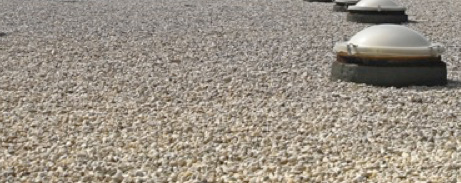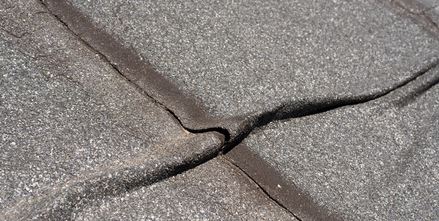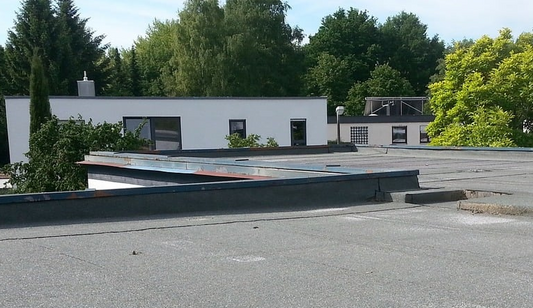Key Points
- Address shrinkage by installing expansion joints and ensuring proper membrane relaxation before installation.
- Prevent ponding water with adequate roof slope, clear drainage systems, and roof coatings.
- Regularly inspect and replace damaged flashings to maintain watertight integrity.
- Patch leaks promptly using EPDM-compatible materials and consider professional assessments for extensive damage.
- Conduct biannual roof inspections and maintain cleanliness to enhance longevity and performance.
Identifying EPDM Roof Issues
Over time, you may notice several signs that suggest problems with your EPDM roofing.
The first telltale sign is shrinkage. EPDM material can contract over time, pulling at the seams and flashing.
This tension might cause your roof to tear or create gaps that lead to leaks. You'll want to inspect the edges and corners of your roof regularly for any signs of pulling or tearing.
Another issue is surface cracking.
Although EPDM is durable, exposure to UV rays and extreme weather can make the surface brittle and prone to cracks.
During your routine checks, look closely for any small cracks or crazing on the surface. These can eventually deepen, compromising the integrity of your roofing system.
You should also be wary of seam failures.
EPDM roofs are pieced together at seams, which are vulnerable to separation or failure, especially if not installed correctly.
Check the seams for any signs of separation or visible damage, as this can be a precursor to more serious issues.
Lastly, if you notice blisters or bubbles under the surface of your roof, it's a sign that air or moisture has been trapped beneath the membrane.
These can weaken your roof's structure, so don't overlook them.
Solving Ponding Water Problems
Addressing ponding water issues on your EPDM roof is essential to prevent premature degradation and potential leaks.
If you're noticing water pooling, it's often due to improper installation or a lack of proper slope for drainage. Start by checking if your roof's slope meets the standard requirements and verify that all drains are clear of debris.
Regular inspections and maintenance are your best defense against ponding water.
During these checks, look for signs of pooling and address them promptly. If the slope of your roof is insufficient, consider applying a roof coating or sealant. These can protect the EPDM membrane from further water damage and extend its lifespan.
In some cases, you might need a more permanent solution like installing a new EPDM roof overlay. This method involves placing a new layer over the existing one, which can be designed to improve overall drainage.
Remember, guaranteeing proper drainage is key; it not only solves current ponding issues but also prevents them in the future.
Don't wait until you see signs of water damage. Proactively managing water accumulation will save you from costly repairs and extend the life of your roof.
Addressing EPDM Shrinkage
Due to its susceptibility to shrinkage, EPDM roofing requires meticulous attention during installation and over its lifespan.
Shrinkage can occur if the membrane isn't installed properly, hasn't had enough time to relax, or is exposed to high temperatures. This can lead to the membrane shrinking, pulling away from structures like parapet walls, and potentially causing water leaks.
To prevent such issues, you need to guarantee the membrane is properly relaxed before it's installed.
This involves laying out the EPDM and allowing it to acclimatize to the environment, which helps prevent contraction after installation.
Additionally, incorporating adequate expansion joints is essential.
These joints accommodate the thermal movement of the roofing material, reducing the stress caused by temperature changes.
Regular inspections are paramount.
You should check your roof periodically, especially after extreme weather conditions, to spot any signs of shrinkage early.
Early detection allows you to address minor issues before they escalate into major problems.
If shrinkage has already occurred, addressing the affected areas promptly is key.
While repairing damaged flashings is a common solution, other measures may include re-sealing the EPDM or, in severe cases, replacing sections of the membrane.
Repairing Damaged Flashings
Flashings are essential to maintaining the watertight integrity of your EPDM roofing system.
If you notice damaged flashings around vent pipes or chimneys, it's pivotal to tackle these repairs quickly to prevent water damage.
Start by inspecting the flashings for signs of wear, such as cracks, rust, or corrosion.
You'll need to replace any deteriorated parts to keep your roof in top condition.
Using flashing tape is a great way to enhance waterproofing, especially around the roof's vulnerable edges and corners.
This tape strengthens these areas, helping to ward off potential leaks.
Make sure you apply it correctly to maximize its effectiveness.
If you find that the flashings are loose or improperly attached, you'll need to re-seal them or consider replacing them entirely.
Ensuring they're securely fastened and sealed prevents water from sneaking into your building.
Preventing and Fixing Leaks
To prevent and fix leaks in your EPDM roofing system, it's crucial to regularly inspect and maintain the roof.
Catching issues early on can save you a heap of trouble, reducing both the extent of damage and the costs of repairs.
Remember, leaks can lead to severe water damage, structural issues, and even health hazards due to mold and mildew buildup.
- Inspect Regularly: Make it a habit to check your roof for signs of wear and tear, especially after severe weather conditions.
- Check Flashings: Verify that all flashings around vents, skylights, and chimneys are intact and securely attached. These are common leak points.
- Apply Sealant: Use a high-quality roof coating or sealant on the EPDM membrane to fill in any small cracks or gaps, adding an extra layer of waterproofing.
- Patch It Up: For visible damages, promptly patch and seal the affected area using EPDM-compatible materials to prevent water from seeping through.
- Consider Professional Help: Don't hesitate to call in roofing professionals if you're unsure about the condition of your roof or how to address a leak.
Ensuring Proper Installation Techniques
Ensuring your EPDM roofing is installed correctly can substantially reduce future problems, such as leaks or premature wear.
You've got to start with the right foundation. Verify the decking is smooth and devoid of any moisture, debris, or damage. It's vital because any imperfections can affect the membrane's effectiveness.
Next, it's about choosing the right adhesive. You'll find either water-based or solvent-based options.
Water-based adhesives are better for large, open areas as they're easier to work with and less toxic. However, solvent-based adhesives are recommended for areas prone to high moisture.
When applying the membrane, take your time to align everything correctly.
Avoid stretching the material too much, which can lead to thinning and weak spots. The seams need special attention—they should overlap by at least 3 inches.
Apply seam tape or a liquid adhesive for a watertight seal, pressing firmly to guarantee it bonds well.
Don't forget the edge details.
Secure the membrane edges with a termination bar to protect against wind uplift and guarantee long-term durability.
This step prevents the roof from peeling back and causing significant issues.
Regular Maintenance Strategies
While proper installation sets a strong foundation for EPDM roofing, regular maintenance remains key to prolonging its lifespan and preventing serious issues.
You've got to stay on top of it, guaranteeing your roof's durability and functionality.
Here's how you can keep your EPDM roof in top shape:
- Biannual Inspections: Spring and fall are ideal for checking your roof's condition. Look for signs of wear and tear or any small issues that could escalate.
- Apply Protective Coatings and Sealants: These products enhance your roof's resistance to water and environmental damage. It's like giving your roof a shield against the elements.
- Routine Cleaning: Keep the surface free from debris and dirt. Use a soft-bristled broom or a gentle, non-abrasive cleaner to avoid scratching the EPDM material.
- Check and Reseal Seams: Verify that all seams are intact and watertight. Re-sealing them as needed prevents water from seeping through and causing internal damage.
- Remove Mold and Mildew: Regularly clean off any mold or mildew, which can degrade the roof material over time.
Adopting these practices not only extends the life of your roof but also saves you from costly repairs down the road. Stay vigilant and your EPDM roof will serve you well for years.




